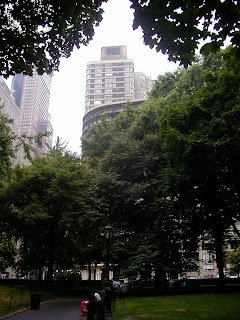For the last few months, I've been pondering a little incident in New York City. It was Memorial Day Weekend, and I was playing host to Felix, a friend from Mexico who had never been to the US. I'm not in the least a New York City guy, but this is my country. Felix had hosted me at his modest home in Oaxaca State, and now he was attending a United Nations conference of indigenous peoples, so I felt privileged to go to New York (by train, of course!) and show him around a little.
We had walked up Fifth Avenue, past imposing buildings, classic churches, and crowds of weekend tourists, to Central Park. I had been looking forward to sharing the park with Felix, but after ten minutes or so, he asked to go back to the streets. "I have plenty of trees where I live; I didn't come to New York to see more of them," he said. Of course, like any good host, I acceded to my guest's wishes and headed with him to the nearest park exit.
Felix and I had a good visit, and we both enjoyed the scenes of the city. We rode the A train all the way to Far Rockaway and basked briefly on the boardwalk by the sea. But his remark about the trees stuck in my mind like a bit of fiber caught between my teeth, and it wasn't until this morning that I was able to work it out in the shower (where my best thoughts often come!).
 Felix grew up and lives on a rugged mountainside, cloaked in majestic trees. Right outside his family's front door are a coffee tree and a cacao tree. The scene is spectacular, uplifting, inspiring. Making a living there is tough, and they're isolated by lack of transportation and rains that turn the hillside into a slick mud-slope. Felix had to carry 50-kilo bags of cement on his back up the hill to build his house. I can understand why he doesn't totally "appreciate" the beauty of his spectacular mountainside retreat, and enjoyed seeing what it was like to live in a place where streets are level and well paved.
Felix grew up and lives on a rugged mountainside, cloaked in majestic trees. Right outside his family's front door are a coffee tree and a cacao tree. The scene is spectacular, uplifting, inspiring. Making a living there is tough, and they're isolated by lack of transportation and rains that turn the hillside into a slick mud-slope. Felix had to carry 50-kilo bags of cement on his back up the hill to build his house. I can understand why he doesn't totally "appreciate" the beauty of his spectacular mountainside retreat, and enjoyed seeing what it was like to live in a place where streets are level and well paved.
But I still felt disappointed that he hadn't spent more time in Central Park. It was certainly logical that he didn't want to "see more trees", and I couldn't understand why I felt let down.

To me, the skyscrapers of a city are impressive and the trees are beautiful, but it's the sight high-rise buildings through the trees that brings me a true sense of awe. The contrast of the natural with the man-made is what expresses the full humanity of the city. Each without the other is insufficient for our needs. Humanity cannot reach it fullest potential living in a forest, beautiful as it may seem. Nor can it attain the heights of its capacity in a "concrete jungle".
I guess that's what I wanted Felix to see. I'm just sorry it took me so long to express it.
PS - I've decided not to blog more from the Moving Minds conference. There's another day-and-a-half, and some of the topics, like transportation security, are beyond my scope. I'm sure a few more good ideas are will to pop out, but I'm also sure the majority have surfaced. Now, on to action!





No comments:
Post a Comment